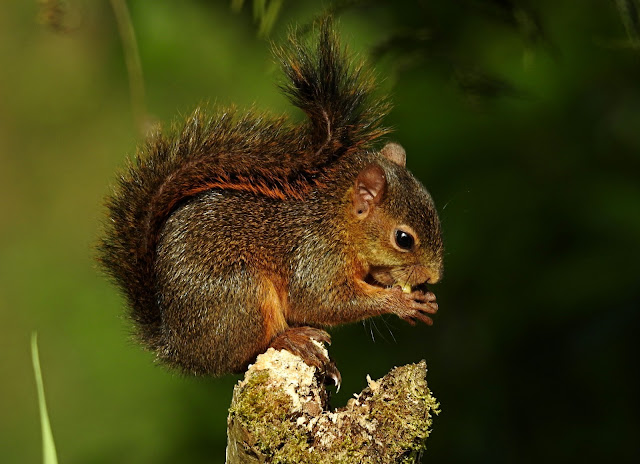This Blog contains Wildlife, Plants and Bird Photos from Walks, Safaris, Birding Trips and Vacations. Most of the pictures have been taken with my Nikon P900 and P950X cameras. Just click on any image for a larger picture. On the right column under the Blog Archive are the entries by date. Below that under Animal categories all the diffent species of Animals, Birds, Insects and Plants contained in the website are listed. Clicking on any entry will show all the entries for that species.
TOTAL PAGEVIEWS
TRANSLATE
Friday, 31 March 2017
1-4-2017 MIAMI, FLORIDA - FLORIDA SCRUB JAY ((Aphelocoma coerulescens)
1-4-2017 MIAMI, FLORIDA - LIMPKIN (Aramus guarauna)
The limpkin (Aramus guarauna), also called carrao, courlan, and crying bird, is a large wading bird related to rails and cranes, and the only extant species in the family Aramidae. It is found mostly in wetlands in warm parts of the Americas, from Florida to northern Argentina, but has been spotted as far north as Wisconsin. It feeds on molluscs, with the diet dominated by apple snails of the genus Pomacea. Its name derives from its seeming limp when it walks.
The limpkin occurs from peninsular Florida (and the Okefenokee Swamp in southern Georgia) and southern Mexico through the Caribbean and Central America to northern Argentina. In South America, it occurs widely east of the Andes; west of them its range extends only to the Equator.
It inhabits freshwater marshes and swamps, often with tall reeds, as well as mangroves. In the Caribbean, it also inhabits dry brushland. In Mexico and northern Central America, it occurs at altitudes up to 1,500 m (4,900 ft). In Florida, the distribution of apple snails is the best predictor of where limpkins can be found.
The limpkin undertakes some localized migrations, although the extent of these is not fully understood. In some parts in the northern part of the range, females (and a few males) leave the breeding areas at the end of summer, returning at the end of winter. In Brazil, birds breeding in some seasonal marshes leave during the dry season and return again with the rains. Birds may also migrate between Florida and Cuba, as several limpkins on the Florida Keys and Dry Tortugas have been reported, but these records may also represent vagrants or postbreeding dispersal. One study in Florida using wing tags found limpkins dispersed up to 325 km (202 mi) away from the breeding site. This tendency may explain vagrant limpkins seen in other parts of the United States and at sea near the Bahamas.
1-4-2017 MIAMI, FLORIDA - WHITE CROWNED PIGEON (Patagioenas leucocephala)
1-4-2017 MIAMI, FLORIDA - RED SHOULDERED HAWK (Buteo lineatus)
The red-shouldered hawk (Buteo lineatus) is a medium-sized buteo. Its breeding range spans eastern North America and along the coast of California and northern to northeastern-central Mexico. It is a permanent resident throughout most of its range, though northern birds do migrate, mostly to central Mexico. The main conservation threat to the widespread species is deforestation.
31-3-2017 MIAMI, FLORIDA - EASTERN POND HAWK DRAGONFLY (Erythemis simplicicollis)
29-3-2017 TARCOLES RIVER, COSTA RICA - BLUE CAPPED MOTMOT (Momotus coeruliceps) (COURTESY MRS VALERIE FISHER)
Thursday, 30 March 2017
31-3-2017 MIAMI, FLORIDA - FOUR STRIPED LEAFTAIL DRAGONFLY (Phyllogomphoides stigmatus)
31-3-2017 MIAMI, FLORIDA - HALLOWEEN PENNANT DRAGONFLY (Celithemis eponina)
26-3-2017 RANCHO NATURALISTA - VARIEGATED SQUIRREL (Sciurus variegatoides)
26-3-2017 RANCHO NATURALISTA - GREEN BASILISK (Basiliscus plumifrons)
29-3-2017 HOTEL BOUGANVILLEA,COSTA RICA - WHITE WINGED DOVE (Zenaida asiatica)
29-3-2017 HOTEL BOUGAINVILLEA,COSTA RICA - HOFFMANN'S WOODPECKER (Melanerpes hoffmannii)
Wednesday, 29 March 2017
28-3-2017 VILLA LAPAS, COSTA RICA - MANGROVE BLACK HAWK (Buteogallus anthracinus ssp. subtilis)
29-3-2017 PUNTARENAS, COSTA RICA - SAVANNA HAWK (Buteogallus meridionalis)
28-3-2017 VILLA LAPAS, COSTA RICA - AMERICAN GREAT EGRET (Ardea alba ssp. egretta)
28-3-2017 VILLA LAPAS, COSTA RICA - SCARLET MACAW (Ara macao)
28-3-2017 TARCOLES RIVER, COSTA RICA - OSPREY (Pandion haliaetus)
19-3-2017 BUTTERFLY WORLD, FLORIDA - MALACHITE BUTTERFLY (Siproeta stelenes)
26-3-2017 RANCHO NATURALISTA - ZEBRA LONGWING BUTTERFLY (Heliconius charithonia)
26-3-2017 RANCHO NATURALISTA - RED POSTMAN BUTTERFLY (Heliconius erato)
Tuesday, 28 March 2017
26-3-2017 RANCHO NATURALISTA - BANDED PEACOCK BUTTERFLY (Anartia fatima)
23-3-2017 TROGON LODGE COSTA RICA - LONG TAILED SILKY FLYCATCHER (Ptiliogonys caudatus)
28-3-2017 TARCOLES RIVER COSTA RICA - GREEN HONEYCREEPER (Chlorophanes spiza)
The green honeycreeper (Chlorophanes spiza) is a small bird in the tanager family. It is found in the tropical New World from southern Mexico south to Brazil, and on Trinidad. It is the only member of the genus Chlorophanes.
The green honeycreeper is 13–14 cm (5.1–5.5 in) long and weighs 14 to 23 grams (0.49 to 0.81 oz), averaging about 19 grams (0.67 oz). It has a long decurved bill. The male is mainly blue-tinged green with a black head and a mostly bright yellow bill. The female green honeycreeper is grass-green, paler on the throat, and lacks the male's iridescence and black head. Immatures are plumaged similar to females. The call is a sharp chip.
This is a forest canopy species. The female green honeycreeper builds a small cup nest in a tree, and incubates the clutch of two brown-blotched white eggs for 13 days. It is less heavily dependent on nectar than the other honeycreepers, fruit and seeds being its main food (60%), with nectar (20%) and insects (15%) as less important components of its diet.
%2020.jpg)
%2020.jpg)


%20(COURTESY%20MRS%20VALERIE%20FISHER)%2020.jpg)
%20(COURTESY%20MRS%20VALERIE%20FISHER)%2021.jpg)

%2020.jpg)






%2020.jpg)
%2020.jpg)
%2020.jpg)
%2021.jpg)
%2022.jpg)
%2010.jpg)


%2021.jpg)













%2020.jpg)
%2026.jpg)
%2021.jpg)
%2022.jpg)
%2025.jpg)
%2023.jpg)
